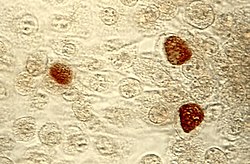Sexually transmitted infections
From WikiLectures
Sexually transmitted diseases include infectious diseases, whose spread is closely linked to intercourse and other sexual practices. It is transmitted by mucous secretions, blood, saliva or semen. They primarily affect the genital system, possibly the urinary tract or other organs. The most common STDs include: syphilis, gonorrhea, chlamydial infection (lymphogranuloma venereum), trichomoniasis, HPV infection, genital herpes (HSV), HIV infection a viral hepatitis type B.
In recent years, there has been a worldwide increase in the incidence of this disease (approx. 375 million newly infected annually).
Compulsory reporting: syphilis, gonorrhea, lymfogranuloma venereum and HIV/AIDS.[1]
| Sexually transmitted infections and their agents | ||
|---|---|---|
| Disease | Agent | |
| Bacterial | Gonorrhea – gonorrhea | Neisseria gonorrhoeae |
| Syphilis – lues | Treponema pallidum | |
| Ulcus molle – Chancroid | Haemophilus ducreyi | |
| Granuloma inguinale – donovanosis | Calymmatobacterium granulomatis | |
| Chlamydia | Chlamydia trachomatis | |
| Mycoplasma | Mycoplazma hominis, M. genitalium | |
| Ureaplasma | Ureaplasma urealyticum | |
| Viral | HIV/AIDS | Human Immunodeficiency Virus |
| Viral hepatitis type B | Hepatitis B virus | |
| Herpes genitalis | Herpes simplex virus 1, 2 | |
| Condylomata accuminata | Human papillomavirus | |
| Molluscum contagiosum | Molluscum contagiosum virus MCV | |
| Yeast | Candida infections | Candida albicans |
| Parasitic | Pediculosis pubis | Pthirus pubis |
| Scabies – scabies | Sarcoptes scabiei | |
| Protozoan | Trichomonad vulvovaginitis | Trichomonas vaginalis |
- Chlamydia trachomatis
- A common infection in women that also affects the cervix. Clinically, it manifests as a mucopurulent discharge, but the majority of those infected are symptomatic. In women, we usually encounter vaginitis (unpleasant itching of the genitals with discharge) and cervicitis, next there can be Salpingitis, endometritis or involvement of the pelvic organs can also occur . In men, the typical manifestation is urethritis (excretion of secretions), but conjunctivitis, proctitis, epididymitis and prostatitis can also occur. In both sexes, it can manifest as lymphogranuloma venerum (rare in the Czech Republic).
- Trichomoniasis
- Gonorrhea occurs in both women and men. In addition to purulent inflammation of the urethra, it manifests itself as cervicitis and salphingitis and, depending on the method of sexual intercourse, as proctitis, pharyngitis and conjunctivitis.
- Untreated, it can even cause inflammation of the joints, endocarditis or purulent infection of the pelvic floor. It can also be the cause of septic abortion.
- Trichomoniasis
- It also occurs in both women and men. In women, it is manifested by a characteristic foamy, smelly discharge.
- Yeast infections
- In the case of yeast infections, there is a so-called "ping-pong" transmission from partners, which means that it is necessary to treat the sexual partner/s as well.
- Mycoplasma hominis
- A bacterium that often colonizes the urogenital tract. It causes urethritis, prostatitis, endometritis or neonatal pneumonia.
- HPV (human papillomavirus)
- A set of many virus serotypes that cause a diverse clinical picture. Sexually transmitted types tend to be risk factors for cervical, laryngeal or colorectal cancer. Clinically, they manifest as papillomas, verruca vulgaris, hyperplasia of the mucous membranes, or as condylomata accuminatum in the area of the vulva and anus.
- We use vaccination for primary prevention (Cervarix – against 2 serotypes, covered by the insurance company for girls and boys between 13-14 years old; Gardasil 9 – against 9 serotypes)
- Herpes genitalis (HSV)
- After contracting this infection, the penis or labia are affected superficially.
- Bacterial vaginosis
- Typical fluoride with a "fishy smell". It occurs mainly in women, in men it causes maximum pain in the urethra.
- Syphilis (Lues)
- A chronic, systemic disease with a characteristic course of alternating symptomatic and asymptomatic periods.
- Molluscum contagiosum
- Molluscum contagiosum are proliferative infections on or around the genitals.
Selected sexually transmitted diseases and principles of therapy[edit | edit source]
| Disease | Agent | Example of treatment |
|---|---|---|
| Gonorrhoea | Neisseria gonorrhoeae | Cefriaxone, Azithromycin |
| Urethritis | Chlamydia trachomatis | Tetracycline |
| Ureaplasma urealyticum | Fluoroquinolone | |
| Vaginitis | Candida albicans | Fluconazole |
| Trichomonas vaginalis | Metronidazole | |
| Vaginosis | Gardnerella vaginalis | Metronidazole |
| Syphilis | Treponema pallidum | Penicillin |
| Ulcus molle | Haemophilus ducreyi | Ceftriaxone, azithromycin |
| Granuloma inguinale | Calymmatobacterium granulomatis | Tetracycline, erythromycin |
| Pelvic floor inflammatory disease | Chlamydia trachomatis | Tetracycline, erythromycin |
| Herpes genitalis | Herpes virus hominis | Aciclovir |
| Condyloma accuminatum | Papillomavirus | Topical treatment |
| AIDS | HIV | Zidovudine, Nevirapine |
Links[edit | edit source]
Related articles[edit | edit source]
References[edit | edit source]
- ↑ KUBICOVÁ, M. Pohlavně přenosné nemoci u dospívajících. Pediatrie pro praxi. 2015, y. 16, no. 6, p. 404-409,
- SCHINDLER, Jiří. Mikrobiologie pro studenty zdravotnických oborů. 1. edition. Grada, 2010. ISBN 978-80-247-3170-4.




